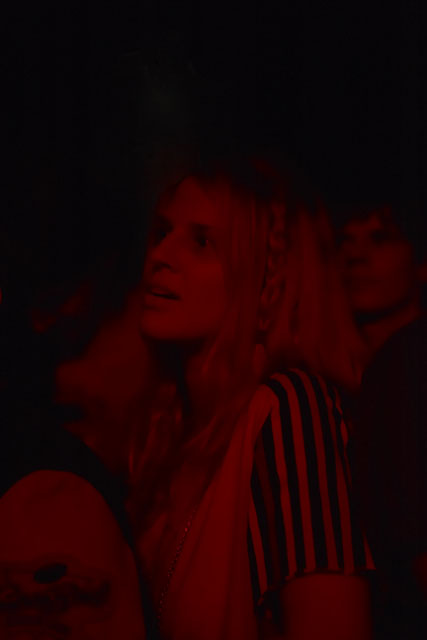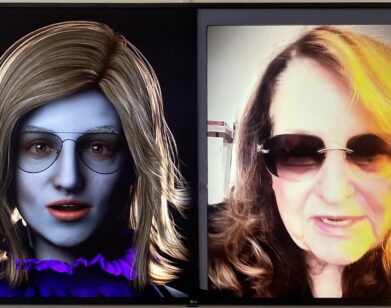Strike a Pose

When you’re lost in your rock-star idol’s performance, you may be captivating Poppy de Villeneuve, the London-born and New York-based photographer who will be shooting candid photos of enthralled fans for her upcoming solo exhibition at the Soho Grand’s gallery. De Villeneuve began her series at the All Tomorrow’s Parties music festival and will proceed with a series of impromptu portraits taken at upcoming concerts and gigs.
In contrast to de Villeneuve’s objective approach to her subjects is Ryan McGinley’s recent concert series. Unlike McGinley, who shares the rapture of fellow Morrissey fans which he documented for his series Irregular Regulars, de Villeneuve is more interested in the demographics of the crowd brought together by the act on stage. Her work looks specifically at the power shared by popular musicians to emotionally move different typologies of fans.
Poppy is accustomed to art’s impact on people’s senses. She’s the 29-year-old daughter of legendary sixties British photographer Justin de Villeneuve and top Ohio-born sixties model Jan de Villeneuve; her sister, Daisy, is a highly sought after illustrator. For her own work, Poppy de Villeneuve has shot for Dazed & Confused, Vogue and Jimmy Choo and produced powerful portraits of inmates in maximum security prisons and people living in the rough landscape of the Rio Grande region, between Mexico and Texas. Here we discuss the comparatively uplifting environment of a passion-inspiring rock concert.
ANA FINEL HONIGMAN: Is music an important part of your life?
POPPY DE VILLENEUVE: Peoples inner lives are something I’m really interested in and music is such an interesting stimulant. For me, I also love discovering new music and remembering what a certain song meant to me at a certain time in my life.
AFH: What song has been important to you longest?
PdV: “Ohio,” by Neil Young
AFH: Are you mostly attending concerts where you like the music?
PdV: That doesn’t matter to me. What matters will be the logistics of where I can roam in and around the crowd, and not get thrown into the mosh pit.
AFH: How are you selecting who you photograph at the concerts?
PdV: I have key artists whose fans have a certain look. I like the idea that different musicians will have different crowds, so I intend to scope out the most poignant fans and join the crowd. It should reveal itself to me.
AFH: By “poignant fans” do you mean “ardent” or is there something else you’re seeing in them that moves you?
PdV: “Ardent” is a good word! As a photographer, I don’t know until I see it, but something makes me choose one person over another. It’s something indescribable.
AFH: Are you interested in the sociological study of fandom?
PdV: I’m interested in the tribes, and the microcosm of behavior in groups representing a bigger situation.
AFH: What situation, besides perhaps a secular form of worship, do you see represented by fans’ energy?
PdV: I think it’s also about community. Perhaps it is about focusing on something that can define you in a certain way.
AFH: Do you think that something is inherently interesting because it’s popular? Are you interested in parsing the logic behind mass culture?
PdV: I’m more interested in the individual, but I think you see something of the individual within the group context. I’ve always been drawn to the individual in the group….how we fit in or not…I try not to get too heady about it and let the pictures find the logic rather than piecing it together before.
AFH: Will you include information on which shows you were photographing in the titles?
PdV: I want to label each person with the band. I’m going to collect as much information as possible. I think it’s important to give a few simple facts and to put things in context.
AFH: When you say that bands have “different crowds,” are you mostly responding to the audience’s style, or are you interested in different demographics—say older audiences or more affluent fans?
PdV: I’m interested in the demographics, but don’t yet know who I’ll find. I think a cross over of ages would be amazing, but I don’t know if I’ll find that. I hope so.
AFH: Have you spoken to any of the fans you photographed before or after you took their picture?
PdV: Sometimes you need an exchange, so they understand why you’re photographing them, and sometimes they don’t even notice. I want to talk the subjects if it doesn’t interfere with the pictures.
AFH: How does a project like this differ from your photojournalist work beside that you’re creating your own assignment?
PdV: I create most of my own assignments anyway, so it’s pretty similar. In this case I have to fly by the seat of my pants a bit. Sometimes when you’re not tied down to a certain system and have to adjust to the situation, you can get something amazing.
AFH: New York seems to inspire you. What was your image of New York before moving here?
PdV: It’s hard to imagine a New York you are going to actually live in. It’s hard to imagine it’s not going to be a Woody Allen film. I spent time in Manhattan when I was 15 and then I went to clubs with my older sister and we had a wild, crazy time. But I was also really excited to navigate it on my own as a grown-up—not that there really is such a thing. I was just excited to find my community.
Poppy de Villeneuve’s aforementioned exhibition opens May 25. The Soho Grand is located at 310 West Broadway, New York.






